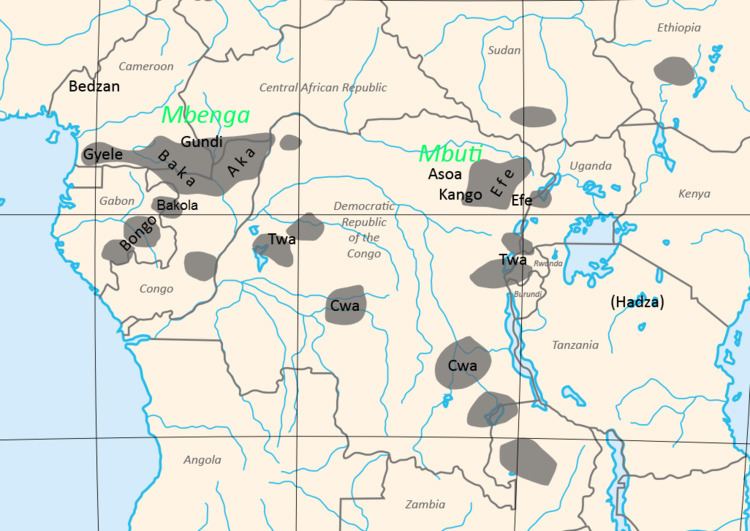 | ||
The Pygmies of Equatorial Africa are those "forest people" who have, or recently had, a deep-forest hunter-gather economy and a simple, non-hierarchical societal structure based on bands, are genetically of short stature, have a deep cultural and religious affinity with the Congo forest, and live in a generally subservient relationship with agricultural "patrons".
Contents
However, these peoples are not related to each other as Pygmies, either ethnically or linguistically. Genetically, different Pygmy peoples have distinct mechanisms for their short stature, demonstrating diverse origins.
Original Pygmy language(s)
An original Pygmy language has been postulated for at least some Pygmy groups. Merritt Ruhlen writes that "African Pygmies speak languages belonging to either to the Nilo-Saharan or Niger–Kordofanian families. It is assumed that Pygmies once spoke their own language(s), but that, through living in symbiosis with other Africans, in prehistorical times, they adopted languages belonging to these two families." The linguistic evidence that such languages existed include Mbenga forest vocabulary which is shared by the neighboring Ubangian-speaking Baka and Bantu-speaking Aka (there is no such common Mbuti vocabulary) and the Rimba dialect of Punu which may contain a core of non-Bantu vocabulary; if this does represent a common ancestral language rather than borrowing, the ancestral speakers may have been part of a complex of non-Pygmoid languages of hunter-gatherer populations in Africa, whose only surviving descendants today mostly ring the rainforest.
A commonly held hypothesis is that African Pygmies are the direct descendants of the Late Stone Age hunter-gatherer peoples of the central African rainforest, who were partially absorbed or displaced by later immigration of agricultural peoples, and adopted their Central Sudanic, Ubangian, and Bantu languages. There is a scarcity of excavated archaeological sites in Central Africa to lead support to this hypothesis, however genetic studies have shown that Pygmy populations possess ancient divergent Y-DNA lineages in high frequencies in contrast to their neighbours.
Some 30% of the Aka language is not Bantu, and a similar percentage of the Baka language is not Ubangian. Much of this vocabulary is botanical, deals with honey collecting, or is otherwise specialized for the forest and is shared between the two western Pygmy groups. It has been proposed that this is the remnant of an independent western Pygmy (Mbenga or "Baaka") language. However this split was only reconstructed as far as the 15th century.
Peoples and languages
There are over a dozen attested Pygmy peoples numbering at least 350,000 in the Congo Basin. The best known are the Mbenga (Aka and Baka) of the western Congo basin, who speak Bantu and Ubangian languages; the Mbuti (Efe et al.) of the Ituri Rainforest, who speak Bantu and Central Sudanic languages, and the Twa of the Great Lakes, who speak Bantu Rwanda-Rundi. All attested Pygmy peoples speak languages from these three language families, and only three peoples, the Aka, Baka, and Asua, have their own language.
Medzan (Bedzan) live in Cameroon not far from the Nigerian border. They speak a dialect of Tikar, a Bantoid language.
The various Twa populations all speak Bantu languages.
Physically, these southern Twa do not differ from their Bantu neighbors, but have a similar subservient position to their agricultural neighbors as the forest Pygmies. They may be remnant Khoisan populations; the Ila, Tonga, and Lenje of Zambia, and the Chewa of Malawi, for example, believe them to be aboriginal peoples, and trace sacred places to them, but Blench suggests that they may have instead migrated from the forest with the Bantu, and were later conflated with aboriginal populations in legend.
